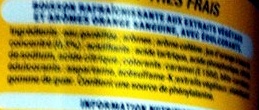coca-cola light sango - 1,5litre
This product page is not complete. You can help to complete it by editing it and adding more data from the photos we have, or by taking more photos using the app for Android or iPhone/iPad. Thank you!
×
Barcode: 5449000123114 (EAN / EAN-13)
Common name: coca-cola light
Quantity: 1,5litre
Brands: Coca-cola
Categories: Beverages, Carbonated drinks, Artificially sweetened beverages, Sodas, Diet beverages, Colas, Diet sodas, Diet cola soft drink
Labels, certifications, awards: Low or no sugar, Low sugar, Reduced sugar
Stores: Auchan
Countries where sold: France
Matching with your preferences
Environment
Packaging
Transportation
Report a problem
Data sources
Product added on by lilimarti
Last edit of product page on by packbot.
Product page also edited by arthurlutz, manu1400, tacite, tacite-mass-editor.
If the data is incomplete or incorrect, you can complete or correct it by editing this page.








